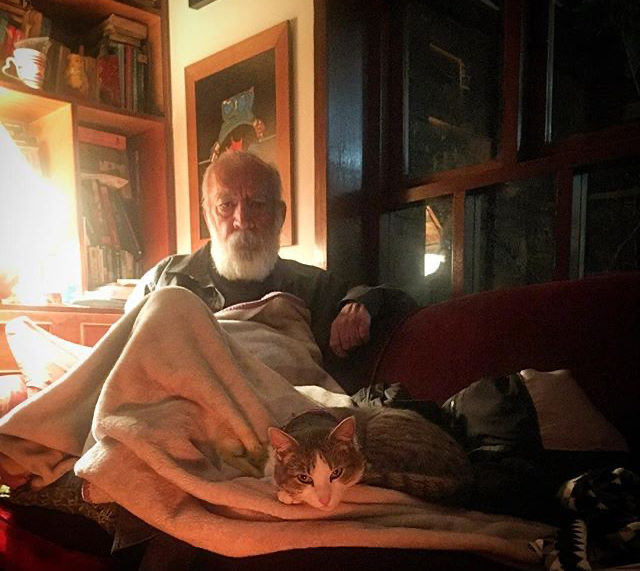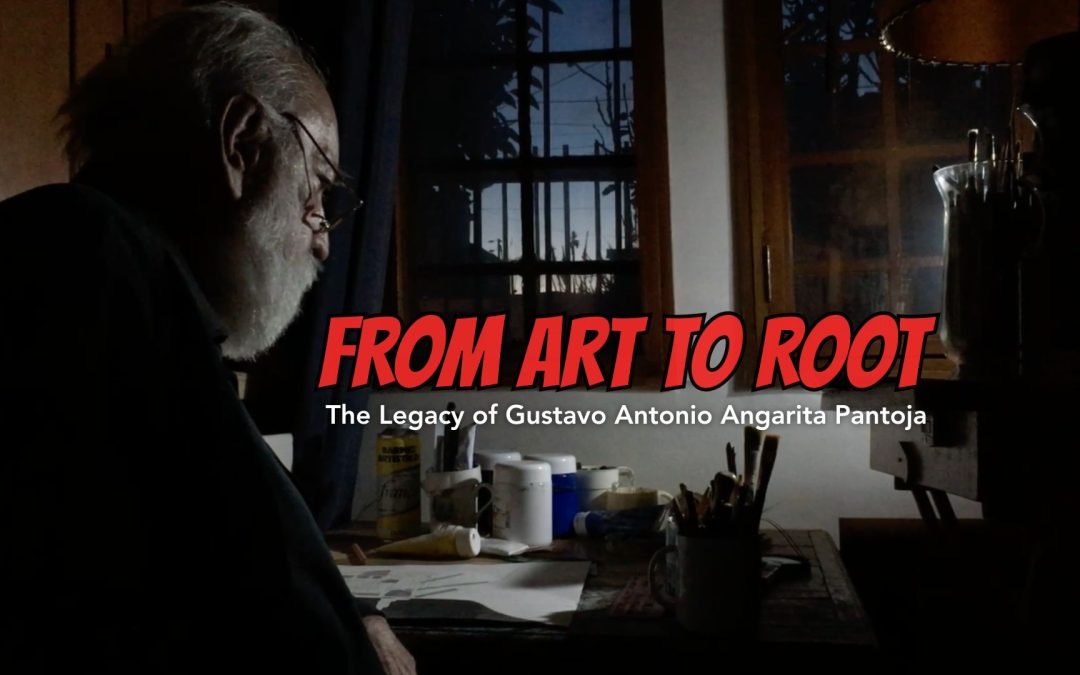In the quiet ache that’s settled over us since we said goodbye to Gustavo—after he left us on October 16, 2025, in his “Casa Museo” in Galerías, a place soaked through with his tastes, his quirks, his canvases—we, at Studio AYMAC, and even more from the bottom of our hearts, the founding partners Gustavo Angarita Jr. and May McCausland, want to keep his flame alive.
We’re selfish, truth be told; we’d have kept him forever by our side, with that feline grace of his and those wide, wondering eyes that drank in the world. But that’s not how it works, nor should it, for a body that slowly lets go, even when the spirit inside—like Gustavo Antonio Angarita Pantoja’s—still burns to swallow the world whole.
A few days have passed since we let go of “Gatito,” our teacher, our north star, our beginning. Today we honour him not just as the heart of our story, but as one of the fullest souls ever to walk the Latin American art world.


Actor. Painter. Philosopher. Ravenous reader. Voice of God. National treasure. Mentor to generations.
Gustavo didn’t just dip into every language of art—he burned through them, reshaped them, made them his own. He did it all: theatre, film, radio, television, big-brand ads, music videos with Tito El Bambino, series with Carlos Vives, international projects alongside names like Antonio Banderas. He was the voice of God in the Vatican Bible. That range turned his voice and face into something Colombians simply knew—the first name that pops into your head when someone says “Colombian actor,” etched into the country’s cultural DNA
He crossed borders in films like Los 33, Gallows Hill, Dominique—acting in French and English without ever speaking a lick of either. That’s the wizardry of a true stage animal. His light blazed in national gems like El olvido que seremos, Tiempo de morir, Sofía y el terco, Bajo la tierra, La estrategia del caracol, Brizna, and countless others. He carried his art around the globe, guest of honour at festivals and tributes galore. He fronted campaigns for Lenovo, Postobón, Coca-Cola, Avianca—always towering, always real, never selling a sliver of his soul.
We’ve yet to meet a director who doesn’t tip their hat to him, a student who doesn’t quote him, a soul who hasn’t seen him breathe truth into a frame.
And still, after all that, he was just the neighbourhood artist, strolling the streets of Galerías where he’d lived over fifty years. There, neighbours greeted him with the quiet reverence saved for the wise—close, human, touchable. The place is so steeped in him that now, when we can’t see him, we only have to walk those streets to feel his spirit twirl inside us, softening the hollow his absence carved.
He was a total creator. Every scene, every word, every brushstroke was a shout into the void. In his own words, every painting was “a piece of himself.”
He filled a room without trying—he didn’t act, he *was*. His untamed mind, forged in the philosophy and literature halls of the National University, was his compass. He was an artist who thought, a philosopher who wore beauty like skin, a man who knew art was also politics, conscience, truth-telling.
At Studio AYMAC, Gustavo wasn’t just inspiration—he was a living pulse, a creative spine. He poured his unmistakable gift into projects like *La Bestia*, *Zona de Espera*, *El Gesto*, *Quédate en Casa*, and *Drama Queens*—the last still in post-production—his mere entrance charging the set like static. He had this gentle, loving way of calling out when a scene, an idea, a move was borrowed. Not to scold, but to nudge you further, to help you find your own voice.
Gustavo asked questions with a pretend innocence—he already knew the answer; his tone gave it away. It was his way of making you think, of quietly setting the world on fire when his restless, untameable spirit demanded it. He read everything: philosophy, new plays, poetry, journalism. Among his deepest bonds was a shared critical, tender gaze on Colombian society with Ernesto McCausland.
In his universe, art wasn’t just shape—it was ethics, quest, truth.
Gustavo Antonio hasn’t vanished, and he never will. He lives in the way we look, in the breath we take before a scene, in the backbone we bring to every story. His creed—“Art isn’t decoration, it’s root”—is branded on our bones.
Studio AYMAC was born on September 2, his birthday, a date we later claimed as living inheritance. Our legal name, Angarita & McCausland Studio, carries his surname because without him none of this would breathe. He gave us more than a name: a way to inhabit the audiovisual world with humanity, rigour, purpose.
During the pandemic, Gustavo Angarita Jr.—actor, director, writer—created the web series *El Gesto*, an intimate work that in just three chapters distils his father’s essence: an artist who turns reality into poetry. A love letter, an early farewell, never meant to be final.
“I paint as a farewell.”
Today, his leaving isn’t emptiness—it’s overflow. Because some people don’t go; they take root. And Gustavo Antonio took root in every gaze, every just word, every silence that said it all. His legacy isn’t a statue: it’s a hum that lingers.
Today his face graces papers near and far. Because he was more than an actor: he was symbol, mirror, art in flesh. And Colombia mourns him the way you mourn someone who no longer belongs just to family or friends, but to a whole country.
This tribute is also a vow:
We’ll keep creating with the same love he taught us to see with.
His presence is seed in every story we choose to tell.
Sensitivity and excellence don’t just coexist—they feed each other.
Thank you, Gustavo Antonio.
For showing us that what lasts isn’t always seen.
But it’s always felt.


Comentarios recientes